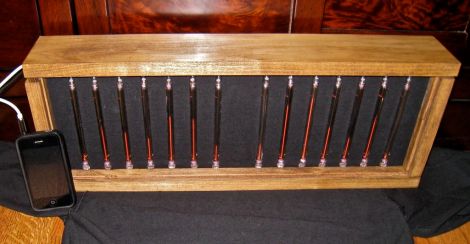
This VU meter uses Nixie tubes as the display. There are a total of fourteen IN-13 bar graph tubes that map out the audio spectrum. The build uses purely hardware for the display; no microcontroller processing, or dedicated VU-meter chips were used.
Input begins with a dual Op-Amp along with a pair of potentiometers which allow the left and right channels to be balanced. Both channels are then each split into seven signals, which explains the layout of tubes seen above. Each signal is then fed through a voltage divider to envelope the output between 0V and 6V. There is also a low-pass filter to handle sudden volume spikes which don’t work well with the nixies. But as shown in the video after the break, all that work has paid off. Thr clip gives us a look at the green protoboards which host all of this filtering hardware. You’ll want to turn the volume down for the first couple of demonstrations which use a sweep to test the system.















Repost.
Kidding, I’m glad this testament to the sloppy soldering and masochistic design of my past keeps cropping up.
I went straight to the video and my head almost exploded
Lesson learnt: always take your time and read the arcticle first
If you mean the volume of the sweep, the lesson here is sound level management.
Don’t keep your system sound at max and adjust with the local control in the player. Keep the volume at max in all playback software and set the system volume to a moderate level.
Also, lower the volume when you stop listening to loud music or low sound level material.
Actually my system volume is always set to 1/3 and youtube volume is less than half…
I guess using headphones played a keyrole here
But… why? Why bother with pure logic when it’s cheaper to use an lm3916 or similar? Or you could use a MSGEQ7 + simple mcu? Cost and portablitlity would be minimal like that.
It’s not pure logic, it’s all analog: partly as a challenge, partly due to costs. The MSGEQ7 was basically impossible to source for a reasonable price until about a year after I made this (This was before sparkfun sold them for $5).
The LM3916 is an LED driver, so I basically implemented the 3916 using cheap comparators with more compatible push-pull outputs (though I now know there are better, simpler analog implementations with a single op-amp).
kind of old, but nixies are always cool
Never going to start with the video first again.
*Somebody*’s got some good taste in music. This is a very cool project.
Sorry, but I LOL’d twice at you guys who damn near blew your heads off by going straight to video. For once I didn’t have my earbuds in!!
Try “Orbit (The Spy)” and “Beatnick Sticks” by Paul Revere and the Raiders.
Instrumentals from before they switched to surf music.